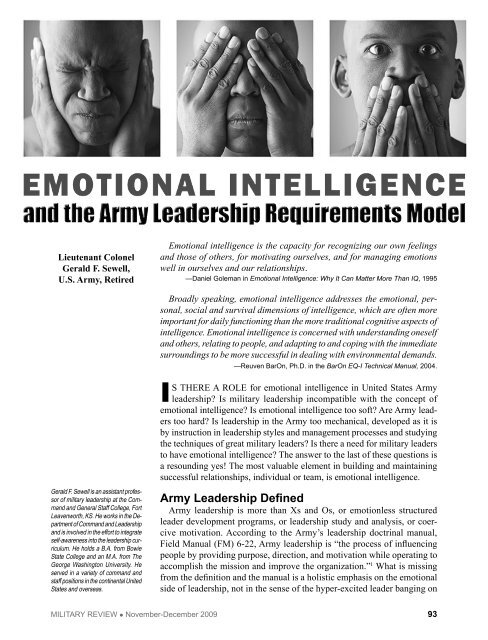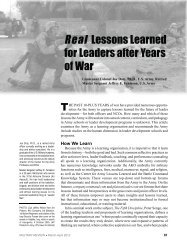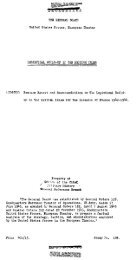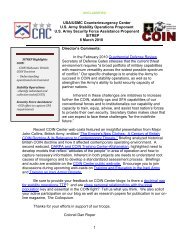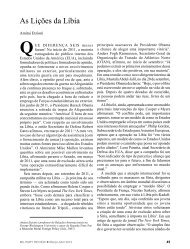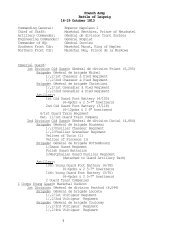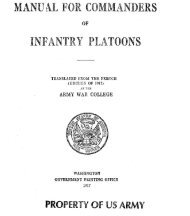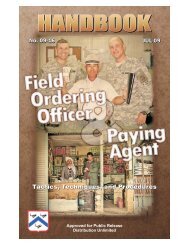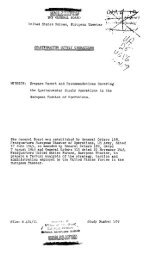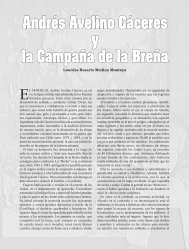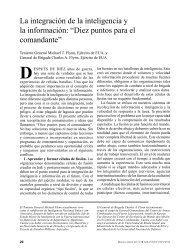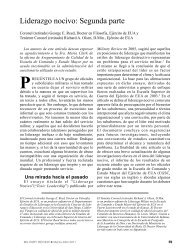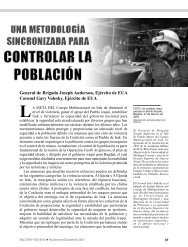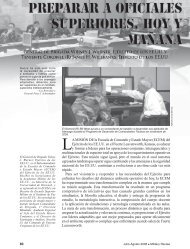Army Leadership Defined - Combined Arms Center - U.S. Army
Army Leadership Defined - Combined Arms Center - U.S. Army
Army Leadership Defined - Combined Arms Center - U.S. Army
You also want an ePaper? Increase the reach of your titles
YUMPU automatically turns print PDFs into web optimized ePapers that Google loves.
Lieutenant Colonel<br />
Gerald F. Sewell,<br />
U.S. <strong>Army</strong>, Retired<br />
Gerald F. Sewell is an assistant professor<br />
of military leadership at the Command<br />
and General Staff College, Fort<br />
Leavenworth, KS. He works in the Department<br />
of Command and <strong>Leadership</strong><br />
and is involved in the effort to integrate<br />
self-awareness into the leadership curriculum.<br />
He holds a B.A. from Bowie<br />
State College and an M.A. from The<br />
George Washington University. He<br />
served in a variety of command and<br />
staff positions in the continental United<br />
States and overseas.<br />
MILITARY REVIEW November-December 2009<br />
Emotional intelligence is the capacity for recognizing our own feelings<br />
and those of others, for motivating ourselves, and for managing emotions<br />
well in ourselves and our relationships.<br />
—Daniel Goleman in Emotional Intelligence: Why It Can Matter More Than IQ, 1995<br />
Broadly speaking, emotional intelligence addresses the emotional, personal,<br />
social and survival dimensions of intelligence, which are often more<br />
important for daily functioning than the more traditional cognitive aspects of<br />
intelligence. Emotional intelligence is concerned with understanding oneself<br />
and others, relating to people, and adapting to and coping with the immediate<br />
surroundings to be more successful in dealing with environmental demands.<br />
—Reuven BarOn, Ph.D. in the BarOn EQ-I Technical Manual, 2004.<br />
IS THERE A ROLE for emotional intelligence in United States <strong>Army</strong><br />
leadership? Is military leadership incompatible with the concept of<br />
emotional intelligence? Is emotional intelligence too soft? Are <strong>Army</strong> leaders<br />
too hard? Is leadership in the <strong>Army</strong> too mechanical, developed as it is<br />
by instruction in leadership styles and management processes and studying<br />
the techniques of great military leaders? Is there a need for military leaders<br />
to have emotional intelligence? The answer to the last of these questions is<br />
a resounding yes! The most valuable element in building and maintaining<br />
successful relationships, individual or team, is emotional intelligence.<br />
<strong>Army</strong> <strong>Leadership</strong> <strong>Defined</strong><br />
<strong>Army</strong> leadership is more than Xs and Os, or emotionless structured<br />
leader development programs, or leadership study and analysis, or coercive<br />
motivation. According to the <strong>Army</strong>’s leadership doctrinal manual,<br />
Field Manual (FM) 6-22, <strong>Army</strong> leadership is “the process of influencing<br />
people by providing purpose, direction, and motivation while operating to<br />
accomplish the mission and improve the organization.” 1 What is missing<br />
from the definition and the manual is a holistic emphasis on the emotional<br />
side of leadership, not in the sense of the hyper-excited leader banging on<br />
93
the desk or screaming at new recruits, or the much<br />
tabooed “touchy-feely” leader, but leaders aware<br />
of their own emotions and how they affect those<br />
around them as they undertake the daily missions<br />
and tasks assigned them. According to psychologist<br />
and author Daniel Goleman, to be successful, a<br />
leader must exercise and be aware of his emotions<br />
and how his emotional competence influences the<br />
way he leads and impacts his followers. 2<br />
FM 6-22 outlines the attributes and competencies<br />
required of <strong>Army</strong> leaders. But who makes up<br />
the <strong>Army</strong>’s corps of leaders? FM 6-22 tells us an<br />
<strong>Army</strong> leader is anyone who, by virtue of assumed<br />
role or assigned responsibility, inspires and influences<br />
people to accomplish organizational goals.<br />
<strong>Army</strong> leaders motivate people both inside and<br />
outside the chain of command to pursue actions,<br />
focus thinking, and shape decisions for the greater<br />
good of the organization. 3 The general public’s<br />
idea of an <strong>Army</strong> leader is the crusty old NCO or<br />
the charismatic officer leading troops into battle or<br />
the well-decorated general giving the inspirational<br />
speech. However, based on the <strong>Army</strong>’s definition,<br />
its leaders are persons that satisfy the responsibilities<br />
within that definition; that is, Soldiers, civilians,<br />
noncommissioned officers, warrant officers, and<br />
commissioned officers; indeed, the full gambit of<br />
personnel in the <strong>Army</strong> system. The <strong>Army</strong> recognizes<br />
that every person has the ability and potential<br />
to be a leader. All of the <strong>Army</strong>’s leaders can benefit<br />
from a greater understanding of their emotions and<br />
the emotions of others.<br />
Emotional Intelligence:<br />
A Brief History<br />
Emotional intelligence is hardly a new field of<br />
study; it is based on a long history of research and<br />
theory in the fields of psychology, human intelligence,<br />
and the social sciences. In his 1983 book<br />
Frames of Mind, Harvard psychologist Howard<br />
Gardner indicates that the study of the emotional<br />
side of intelligence can be traced back to the early<br />
1800s to the studies of Franz Joseph Gall and his<br />
associate, Joseph Spurzheim, who identified the<br />
presence of three affective faculties in the brain—<br />
reverence, self-esteem, and reflective powers. 4<br />
Dr. Reuven BarOn, author and developer of the<br />
Emotional Quotient Inventory, identifies David<br />
Wechsler and his studies on “the nonintellective<br />
aspects of general intelligence” conducted in 1940<br />
as the foundation for the study of emotional intelligence.<br />
5 Some of the most notable groundbreaking<br />
work in the field was done by Gardner. In Frames<br />
of Mind, Gardner proposed that there was not just<br />
one type of intelligence quotient (IQ) that led to<br />
success in life, but a wide spectrum of intelligences<br />
and at least four varieties of interpersonal intelligence.<br />
6 Gardner writes of two types of personal<br />
intelligence that both deal with the emotions. He<br />
speaks of intrapersonal intelligence, which is the<br />
internal aspects of a person, and the interpersonal<br />
intelligence, which turns outward towards other<br />
individuals. 7 Gardner’s groundbreaking work<br />
was further developed by Yale psychologist Peter<br />
Salovey, whose concept of emotional intelligence<br />
included appraising the emotions in self and others,<br />
regulating emotions in self and others, and using<br />
emotions in adaptive ways. 8 These were identified<br />
and described in his 1990 study, conducted with an<br />
associate, Peter Mayer. The term emotional intelligence<br />
was also introduced in this study. 9<br />
Psychologist Daniel Goleman popularized emotional<br />
intelligence with his landmark book of that<br />
name, which became a “household” expression as<br />
well as a field of study worth consideration in the<br />
business, academic, and social-science communities.<br />
Goleman developed his theory about emotional<br />
intelligence through research in more than 200<br />
organizations, explaining that without emotional<br />
intelligence, a person can have first class training,<br />
an incisive mind, and an endless supply of good<br />
ideas, but still not make a great leader. 10 Supported<br />
by his research, Goleman maintained that despite<br />
their cognitive intelligence and business smarts,<br />
executives and managers could not have gained<br />
their levels of success if they had not possessed<br />
emotional intelligence. 11 In his initial research<br />
and theories, based on the findings of Salovey and<br />
Mayer, Goleman adopted a five-domain model,<br />
which he later modified to a four-domain model. 12<br />
…a person can have first class<br />
training, an incisive mind, and an<br />
endless supply of good ideas, but<br />
still not make a great leader.<br />
94 November-December 2009 MILITARY REVIEW
Although recognized as one of the leading<br />
voices in the emotional intelligence community,<br />
Goleman’s construct is not the only emotional<br />
intelligence model, nor is it the definitive thought<br />
on emotional intelligence. BarOn’s model presents<br />
five realms of emotional intelligence with 15 scales.<br />
Both constructs align with the <strong>Army</strong>’s <strong>Leadership</strong><br />
Requirements Model.<br />
Emotional Intelligence in<br />
U.S. <strong>Army</strong> <strong>Leadership</strong> Doctrine<br />
The U.S. <strong>Army</strong> has long recognized that its success<br />
depends upon its people. The age-old <strong>Army</strong><br />
maxim is “Mission first. People always.” This is<br />
not just lip service. The <strong>Army</strong> spends an exceptional<br />
amount of time emphasizing the importance of<br />
leader-to-follower relationships, teamwork, esprit<br />
de corps, and organizational climate. Each of these<br />
issues requires the holistic inclusion of emotionalintelligence<br />
components in leader-training, doctrine,<br />
and leadership literature.<br />
Field Manual 6-22 does not limit its discussion of<br />
the emotional aspects of leadership to the <strong>Leadership</strong><br />
Requirements Model. Paragraph headings that<br />
sound like emotional intelligence competencies<br />
can be found throughout the manual; paragraphs<br />
address Soldier and leader self-awareness, the<br />
emotional factors [my emphasis] of leadership (self<br />
control, stability, and balance) as well as interpersonal<br />
tact, adaptability, and judgment. 13<br />
The <strong>Army</strong>’s current leadership doctrine promotes<br />
self-aware, adaptive, flexible, and agile leaders.<br />
Each of these elements are competencies of emotional<br />
intelligence. The <strong>Army</strong>’s leadership doctrine<br />
describes its leaders as self-aware and innovative<br />
and identifies the importance of self-awareness:<br />
“Self-awareness has the potential to help all leaders<br />
become better adjusted and more effective. Selfawareness<br />
is relevant for contemporary operations<br />
requiring cultural sensitivity and for a leader’s<br />
adaptability to inevitable environmental change.” 14<br />
Goleman identifies self-awareness as the foundation<br />
for emotional intelligence. 15<br />
What FM 6-22 doesn’t do is threefold. It—<br />
● Does not acknowledge attributes and competencies<br />
as emotional elements, thus implying that<br />
they are hard skills.<br />
● Does not discuss the importance of understanding<br />
and applying the emotional aspects of leadership.<br />
MILITARY REVIEW November-December 2009<br />
E M O T I O N A L I N T E L L I G E N C E<br />
Self-awareness is relevant<br />
for contemporary operations<br />
requiring cultural sensitivity…<br />
● Does not discuss how to develop the skills<br />
necessary to employ the many facets of emotions<br />
successfully.<br />
Taking these steps will enhance the leadership<br />
manuals and provide valuable assistance to <strong>Army</strong><br />
leaders in becoming emotionally intelligent and<br />
more effective.<br />
In June 2008, the <strong>Army</strong> published its study on the<br />
Human Dimension in Full Spectrum Operations,<br />
2015-2024. Despite its title, the manual does not<br />
discuss the emotional aspects of Soldiers and leaders<br />
in peace or in combat where the emotional skills<br />
advanced by emotional intelligence are particularly<br />
critical to understanding how Soldiers react and in<br />
how they develop resiliency. The pamphlet identifies<br />
the human dimension as the moral, cognitive,<br />
and physical components to raise, prepare, and<br />
employ the <strong>Army</strong> in full spectrum operations. 16<br />
However, the pamphlet addresses several aspects<br />
of emotional intelligence. It identifies the need for<br />
leader self-awareness and acknowledgment of this<br />
characteristic in others. The study also identifies the<br />
Soldier-to-leader and leader-to-Soldier socialization<br />
process, both elements of emotional intelligence<br />
and the individual need to develop a broad concept<br />
of social awareness. 17 Identifying these elements as<br />
important to the human dimension is an important<br />
first step. 18<br />
The next step must provide a holistic application<br />
of these elements and others under the umbrella<br />
of emotional intelligence. The study continues the<br />
broad-brush approach of FM 6-22 in addressing the<br />
emotional aspects of Soldiers and leaders. The tenchapter<br />
TRADOC pamphlet briefly touches upon<br />
self-awareness and empathy in chapter 9, which<br />
discusses the requirements and responsibilities<br />
of leadership. Unfortunately, the <strong>Army</strong>’s discussion<br />
of the human dimension does not and is not<br />
intended to address the whole person; rather, it is<br />
based on a holistic view of how humans function<br />
in a system. These systems include environment,<br />
culture, community, politics, and society, among<br />
95
others. 19 The pamphlet defers to FM 6-22 for the<br />
impact of leadership on the human dimension, stating,<br />
“<strong>Leadership</strong> weaves throughout this concept<br />
both explicitly and implicitly. FM 6-22 describes<br />
leadership in detail and from many perspectives.<br />
Rather than restate this information, this chapter<br />
assumes that the essence of leadership is immutable,<br />
and that the characteristics the <strong>Army</strong> wishes to<br />
develop in leaders at all levels will not change significantly.”<br />
20 Identified in FM 6-22 as attributes and<br />
competencies, the characteristics are the elements<br />
that hold the key to using emotional intelligence in<br />
the <strong>Army</strong>’s leadership doctrine.<br />
<strong>Army</strong> <strong>Leadership</strong><br />
Requirements Model<br />
In FM 6-22, the <strong>Army</strong> defines, outlines, and<br />
describes its leadership doctrine. The foundation of<br />
this philosophy is highlighted in the <strong>Army</strong> <strong>Leadership</strong><br />
Requirements Model, which identifies the<br />
attributes and competencies required for successful<br />
leaders. The attributes and competencies parallel<br />
the emotional intelligence constructs of Goleman<br />
and BarOn.<br />
Revised and published in October 2006, FM 6-22<br />
provides a new twist on the <strong>Army</strong>’s historical foun-<br />
►<br />
►<br />
►<br />
ATTRIBUTES<br />
What a Leader is:<br />
A Leader of Character<br />
● <strong>Army</strong> values<br />
● Empathy<br />
● Warrior ethos<br />
A Leader with Presence<br />
● Military bearing<br />
● Physically fit<br />
● Composed, confident<br />
● Resilient<br />
A Leader with Intellectual Capacity<br />
● Mental agility<br />
● Sound judgment<br />
● Innovation<br />
● Interpersonal tact<br />
● Domain knowledge<br />
dation of leadership; the characteristics that describe<br />
what an <strong>Army</strong> leader needs to “Be, Know and Do.”<br />
Although the <strong>Army</strong> still defines its leaders implicitly<br />
in light of Be—the characteristics and attributes a<br />
leader must have, Know—the skills and knowledge<br />
they must possess and develop, and Do—how they<br />
in turn operate with those attributes and skills and<br />
knowledge, it no longer stresses those terms. In the<br />
2006 rewrite, the <strong>Army</strong> determined that it was more<br />
important to place the doctrinal emphasis on leader<br />
intangibles, in the sense of leader attributes and in<br />
the leader skills in the competencies that a leader<br />
must have. <strong>Army</strong> leadership experts have developed<br />
a leadership requirements model designed around<br />
leadership attributes, the new combined “Be and<br />
Know,” and leadership competencies, the new “Do”<br />
(see Figure 1).<br />
FM 6-22 notes the model’s basic components<br />
center on what a leader is and what a leader does.<br />
The leader’s character, presence, and intellect<br />
enable the leader to master the core leader competencies<br />
through dedicated lifelong learning.<br />
The balanced application of the critical leadership<br />
requirements empowers the <strong>Army</strong> leader to build<br />
high-performing and cohesive organizations able<br />
to effectively project and support land power.<br />
CORE LEADER COMPETENCIES<br />
What a Leader Does:<br />
Leads<br />
● Leads others<br />
● Extends influence beyond the<br />
chain of command<br />
● Leads by example<br />
● Communicates<br />
Develops<br />
● Creates a positive environment<br />
● Prepares self<br />
● Develops others<br />
Achieves<br />
● Gets results<br />
Figure 1. <strong>Leadership</strong> Requirements Model from FM 6-22.<br />
96 November-December 2009 MILITARY REVIEW<br />
►<br />
►<br />
►
It also creates positive organizational climates,<br />
allowing for individual and team learning, and<br />
empathy for all team members, Soldiers, civilians,<br />
and their families. 21<br />
Inherent in each of the attributes (what an <strong>Army</strong><br />
leader is) and the competencies (what an <strong>Army</strong><br />
leader does) are the elements of emotional intelligence.<br />
The attributes and competencies are compatible<br />
with the Goleman model and fit neatly into<br />
the domains of emotional intelligence.<br />
The Model Crosswalk<br />
The twelve <strong>Army</strong> leader attributes align within<br />
Goleman’s domains with crossover into both<br />
personal and social competence areas. Seven of<br />
the twelve attributes fit nicely into the personal<br />
competence area as they deal specifically with the<br />
personal characteristics of the individual leader<br />
and what a leader must be (see Figure 2). The eight<br />
leader competencies fit into both sides of the chart<br />
and each of the eight falls under the relationship<br />
management domain as they involve establishing<br />
relationships and dealing with others. The com-<br />
MILITARY REVIEW November-December 2009<br />
E M O T I O N A L I N T E L L I G E N C E<br />
parison demonstrates that the emotional aspects<br />
of leader attributes and competencies correlate<br />
with the emotional intelligence competencies of<br />
the Goleman model.<br />
Emotional intelligence is about understanding<br />
your own emotions and those of others in order to be<br />
a more successful person. The leader attributes and<br />
competencies assist leaders in becoming better leaders<br />
by understanding themselves and others as well<br />
as their relationships to others as they lead people<br />
and organizations. The <strong>Army</strong>’s leader development<br />
programs will do a great service to its leaders by<br />
placing increased emphasis on the emotional intelligent<br />
aspects of leadership.<br />
It’s not an Oxymoron<br />
The <strong>Army</strong> in its current leadership framework<br />
does not holistically address the importance of the<br />
emotional side of leadership. Despite this, <strong>Army</strong><br />
leader attributes and competencies demonstrate the<br />
importance of emotional intelligence to <strong>Army</strong> leaders.<br />
The relationship of the elements of emotional<br />
intelligence and the <strong>Army</strong> <strong>Leadership</strong> Requirements<br />
PERSONAL COMPETENCE SOCIAL COMPETENCE<br />
Self-Awareness Self-Management Social Awareness<br />
– Emotional Self-<br />
Awareness<br />
– Self-Awareness<br />
– Self -Assessment<br />
– Prepares Self<br />
– Self- Confidence<br />
– Composed, Confident<br />
– Warrior Ethos<br />
– Domain Knowledge<br />
– Military Bearing<br />
– Emotional Self-<br />
Control<br />
– Transparency<br />
– Adaptability<br />
– Resilient<br />
– Mental Agility<br />
– Achievement<br />
– Initiative<br />
– Innovation<br />
– Optimism<br />
– Creates a Positive<br />
Environment<br />
– Physically Fit<br />
– Organizational<br />
Awareness<br />
– <strong>Army</strong> Values<br />
– Service<br />
– Empathy<br />
– Empathy<br />
Relationship<br />
Management<br />
– Inspirational <strong>Leadership</strong><br />
– Leads by Example<br />
– Influence<br />
– Extends influence<br />
– Leads Others<br />
– Communicates<br />
– Developing Others<br />
– Develops Leaders<br />
– Catalyst for Change<br />
– Creates a Positive<br />
Environment<br />
– Conflict Management<br />
– Interpersonal Tact<br />
– Sound Judgment<br />
– Teamwork-collaboration<br />
– Gets Results<br />
Figure 2. <strong>Leadership</strong> Requirements Model and Goleman Model Crosswalk.<br />
97
Model is clear: inherent in the attributes and competencies<br />
are emotional aspects that lead to effective<br />
leadership when understood and employed. The<br />
next step for the <strong>Army</strong> is to incorporate emotional<br />
intelligence in its leader and Soldier development<br />
programs. If <strong>Army</strong> leaders study and apply emotional<br />
intelligence, they will be more effective and successful<br />
in building strong organizations and teams. MR<br />
If <strong>Army</strong> leaders study and apply emotional intelligence, they will be more<br />
effective and successful in building strong organizations and teams.<br />
1. U.S. <strong>Army</strong> Field Manual (FM) 6-22, <strong>Army</strong> <strong>Leadership</strong> (Washington, DC: U.S.<br />
Government Printing Office [GPO], October 2006.), 1-2.<br />
2. Daniel Goleman, “What Makes a Leader,” Harvard Business Review (November-December<br />
1998): 93-102.<br />
3. FM 6-22, 1-2.<br />
4. Howard Gardner, Frames of Mind (New York: Basic Books Inc., 1983), 12.<br />
5. Reuven BarOn, BarOn Emotional Quotient Inventory, Technical Manual (New<br />
York: Multi-Health Systems, 1997), 2.<br />
6. Gardner, 239.<br />
7. Ibid.<br />
8. Peter Salovey and John D. Mayer, Emotional Intelligence (New York: Baywood<br />
Publishing Company, Inc., 1990), 189, 190.<br />
9. Salovey and Mayer, 185.<br />
10. Goleman.<br />
11. Ibid.<br />
NOTES<br />
12. Daniel Goleman, Richard Boyatzis, and Annie McKee, Primal <strong>Leadership</strong><br />
(Boston, MA: Harvard Business School Press, 2002), 38.<br />
13. FM 6-22, 6-4.<br />
14. Ibid, 8-8.<br />
15. Goleman, Boyatzis, and McKee, 30.<br />
16. Ibid, iii.<br />
17. U.S. <strong>Army</strong> Training and Doctrine (TRADOC) Pamphlet 525-3-7-01, Human<br />
Dimension in the Future 2015-2024 (Washington, DC: GPO, 2008), 9.<br />
18. Ibid, 16.<br />
19. Human dimension defined at AUSA, (7 March 2009).<br />
20. TRADOC Pam 525-3-7.<br />
21. FM 6-22, 2-4.<br />
98 November-December 2009 MILITARY REVIEW


